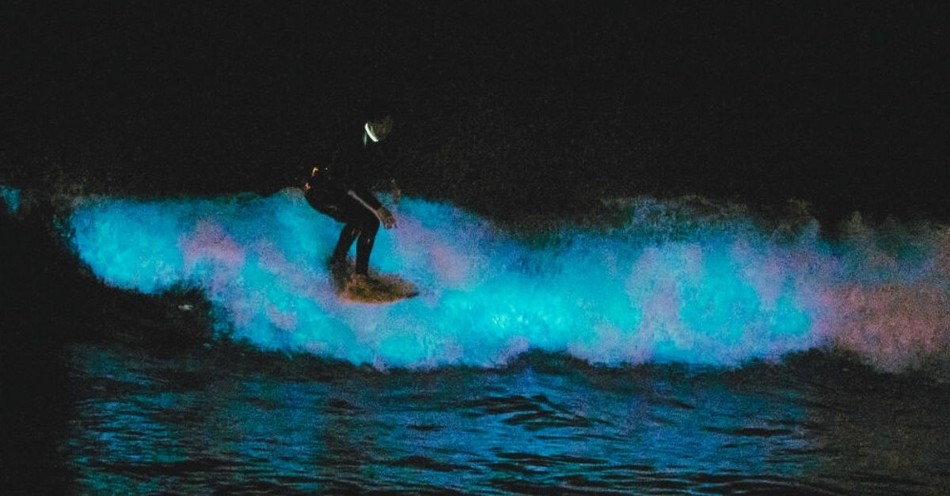Recently, glowing blue waves have been seen along the coast of California as a result of a species of plankton. This plankton, when disturbed, results in bioluminescent glowing blue waves, only visible at night. California isn’t the only place with this phenomenon. Along coasts around the world, in places like Jamaica, Puerto Rico, Japan, Vietnam, and more, scientists, travelers, and locals are marveling at these glowing waves. I was speaking to a friend today about this very topic, and she told me that her husband had seen the bioluminescence from an airplane. She shared about how the wonder and beauty from those moments stuck with her husband in a long-term, powerful way. Wonder can do that.
Getting to witness the glowing waters caused by bioluminescence is considered a rare experience because it is also a temporary experience, sometimes called a fleeting experience. It is a brief moment when the waters light up in the night. It is a small moment that feels like magic because it is unlike what is typical of the waters. It is described as a beautiful site, a beauty that is no doubt bolstered by the fact that glowing water is not typical of our coasts, and many in the world will never experience seeing, kayaking among, or swimming in these glowing waters. While there is a scientific explanation for this, that plankton and other organisms gather and are disturbed by the waters, causing the glow, there is still wonder attached to such an event:
Wonder at the beauty.
Wonder at the fragility of the moment.
Wonder at the uniqueness.
This can lead us to wonder: why would God design something so beautiful in our world? Function and beauty do not necessarily require one another. The plankton and organisms have a function, and being disturbed by the water in a specific season probably also has a function. And then, God gave these functions beauty to reflect in the night. It is enchantingly beautiful, so much so that people are drawn to find and witness this beauty.
I have read articles about the disenchantment of the world today and its impact on the next generation, specifically Gen Z. There seems to be a hunger for truth, but mostly only truth that fits into the natural sciences and the scientific process itself. However, even many scientists can admit there is truth that cannot be proven or has not been proven. When we limit our understanding of truth to what fits in a neat and tidy explanation, our understanding of the world itself becomes limited. This certainly would be true in our understanding of God. We need room to wonder and awe.
These bioluminescent waves have a scientific explanation that fits within the natural sciences, but it cannot explain why it is beautiful. I have doubts that science can explain what constitutes something as beautiful or enchanting and why it is so. Disenchantment works against imagination, and imagination is a God-given gift that can point us back to God. After all, imagine why God made such a beautiful thing to come about.
There are some benefits to these glowing waves as they roll up on shore and invite so many to witness them. These benefits draw us into God’s creative design:
Creation’s Call to Worship
Psalm 65 reminds us that God formed the mountains and the oceans, declaring “The whole earth is filled with awe at your wonders; where morning dawns, where evening fades, you call forth songs of joy” (see Psalm 65:8). Psalm 19 reminds us the heavens declare the glory of God (see Psalm 19:1). This alludes to the idea that creation reflects God in a way that draws awe and wonder. Psalm 33 calls people to wonder at God (see Psalm 33:8). When we experience something in creation, like glowing water, it is evidence that the earth is filled with God’s wonders. It is a proper response to be in awe and wonder. We can wonder how we were one of the few who got to witness such beauty. We can wonder why beauty exists at all. We can wonder at the creativity of God’s design to make such a beautiful moment come about. All of this wonder draws us into a place of awe at who God is. And this can ultimately lead us to worship. We were designed to worship God. The awe and wonder at the creation God designed complements our design to worship God.
I have to give a little context to who I am as I write this. I generally don’t enjoy the outdoors. I don’t seek out beautiful lookouts on a hike, mostly because I very rarely hike. I don’t pause and take in the views. I appreciate beauty in nature, but generally am not motivated by it. I share this with you because I am discussing experiencing awe and wonder in God’s Creation as one who considers this experience a bit of a spiritual discipline, not a natural occurrence. Awe and wonder are a spiritual experience, and sometimes we have to stop and look for it, enter into it, or prepare our heart for it, rather than hope it is a passive experience that happens to us. I can still pause and intentionally enter into awe and wonder rather than hope it happens to me.
To See His Glory, We Must First Be Still
Beautiful, fleeting, rare moments cause us to slow down and pause. The temporary nature of such things requires us to slow down because we may not be able to return to a place or moment in time to experience the bioluminescent waters. They are there in that moment, and in order to see them, we have to be in that moment also. We are designed to slow down and even be still for moments. God’s creation beckons us to do what we were designed to do, to be still and know God is God (see Psalm 46:10). The glowing waves invite us to do just that: slow down, be still, and wonder at God.

We Were Made to Seek the Light
A family in Lakewood sought out different spots on the California coast to find where the bioluminescent waves washed up in order to witness their beautiful glow. They spent time searching for where the light was shining in the waters. There was something special they did not want to miss out on. I can’t help but picture the Magi following a star, a beautiful, fleeting, and unique light that inspired awe and wonder. The light initiated a search by the Magi. It was a search that brought them to Jesus Christ, the promised Messiah. Unlike the unpredictable locations for bioluminescent waves, God assures us that when we seek him, we will find him (See Jeremiah 29:13, Matthew 7:7-8). There is an invitation to seek out God. We were designed to be in a relationship with God. What if this means we are also designed to look for God in order to be in a relationship with Him?
What do these bioluminescent waves teach us about God’s design? They teach us the role of awe and wonder in how God designed us. They teach us that we will search for the relationship with God we were designed for. They teach us that we are designed to be still with God.
Photo Credit: ©Getty Images/Joe Scarnici / Contributor





